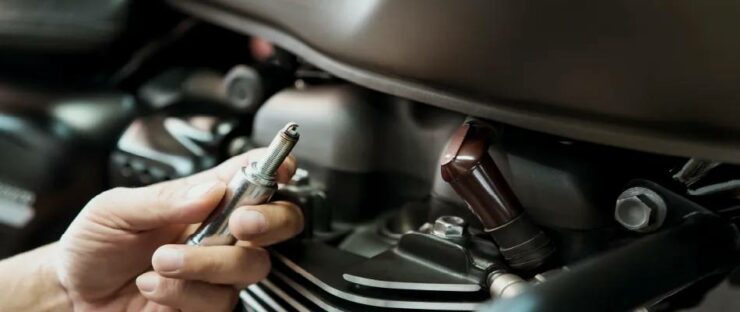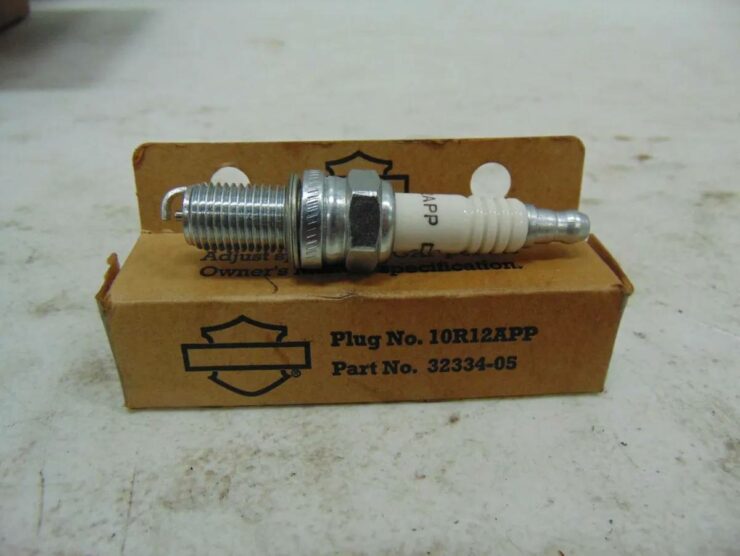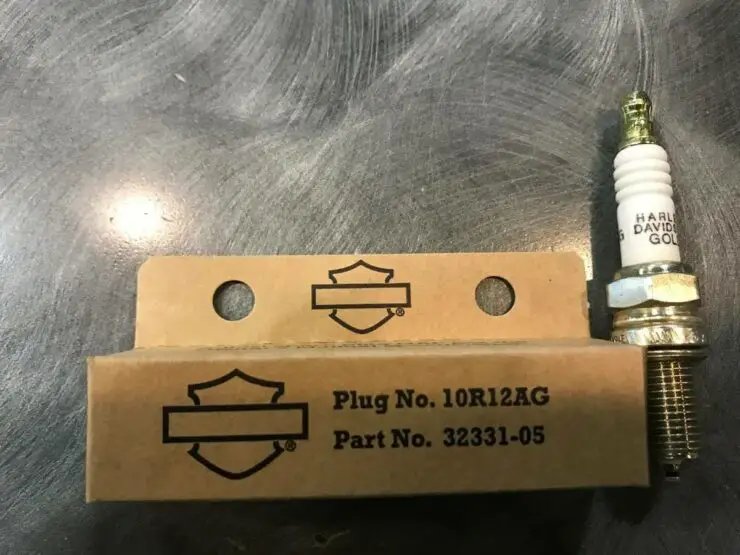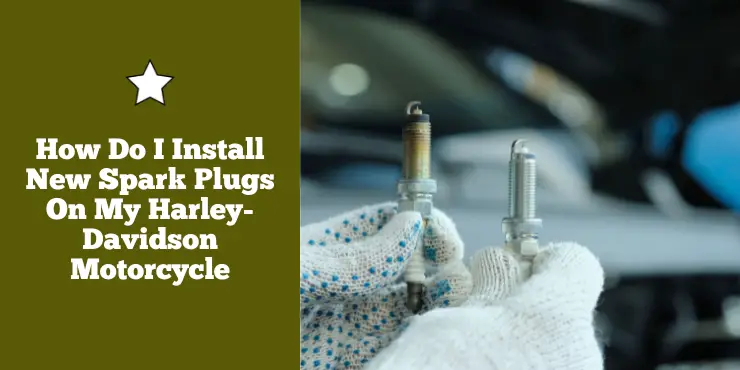Are you a proud owner of a Harley-Davidson motorcycle, itching to give it a little TLC? Well, one of the simplest yet most effective ways to boost your motorcycle’s performance is by installing new spark plugs. But how do you go about this task? Fear not, dear rider, for we have you covered!
To install new spark plugs, remove the old plugs with a spark plug socket, set the gap on the new plugs, screw them in by hand, then tighten with a socket without over-torquing.
In this article, we will guide you step-by-step on how to install new spark plugs on your beloved Harley-Davidson. So, rev up your engines and get ready to embark on this thrilling DIY adventure!
Benefits of spark plug maintenance in Harley-Davidson motorcycles
Owning a Harley-Davidson bike isn’t only about having a mode of transportation, it is also about experiencing a unique lifestyle and a sense of freedom on the open road. To keep your Harley-Davidson bike running smoothly and delivering the exhilarating performance that it is known for, proper maintenance will be needed. Here are some of the benefits of spark plug maintenance in Harley-Davidson motorcycles.
>>> Click here to read our review of the Best Harley-Davidson Spark Plugs <<<
#1. Improved engine performance
Properly maintained spark plugs will play a key role in optimizing your Harley-Davidson bike’s engine performance. They ensure reliable ignition of the air-fuel mixture in the combustion chamber. When the spark plugs are in great condition, your engine runs smoothly, delivers consistent power, and accelerates seamlessly.
#2. Enhanced fuel efficiency
Well-maintained spark plugs will contribute to improved fuel efficiency. When the air-fuel mixture ignites efficiently, it’ll result in more complete combustion. This will result in better fuel economy, allowing you to enjoy longer rides without frequent stops at the gas station.
#3. Reduced emissions
In an era of increasing environmental awareness and stricter emission regulations, spark plug maintenance will help reduce your motorcycle’s carbon footprint. Efficient combustion, achieved through properly maintained spark plugs will produce fewer harmful emissions, making your Harley-Davidson bike more environmentally friendly.
#4. Smoother idling
Spark plug maintenance will ensure a consistent and stable idle for your bike. A rough or irregular idle could be a sign of spark plug issues, and addressing them will result in a more pleasant and comfortable riding experience, especially when sitting at traffic lights or during prolonged periods.
#5. Improved colder-weather starting
Harley-Davidson riders often face different types of weather conditions, including cold temperatures. Well-maintained spark plugs will ensure a strong spark during cold starts, making it easier to fire up the engine and get on the road even in chilly weather.

#6. Increased engine longevity
Neglecting spark plug maintenance can result in engine problems and potentially costly repairs. Damaged or fouled spark plugs can result in misfires, poor combustion, and engine damage over time. Regular spark plug maintenance will help extend the life of your Harley-Davidson bike’s engine.
#7. Consistent and reliable riding experience
Harley-Davidson riders often cherish the predictability and reliability of their motorcycles. With proper spark plug maintenance, you’ll be able to enjoy a consistent and dependable riding experience, reducing the chances of unexpected breakdowns or performance issues during your journeys.
#8. Cost savings
While spark plug maintenance might seem like a small expense compared to other aspects of motorcycle care, it can end up saving you money in the long run. Well-maintained spark plugs will prevent the need for more extensive repairs and improve fuel efficiency, ultimately reducing your overall operating costs.
Different types of spark plugs and how to choose the right one
Spark plugs are a crucial component for igniting the fuel-air mixture in a Harley-Davidson bike’s engine. With various Harley-Davidson models on the market, choosing the correct spark plug can be daunting. With so many different types of spark plugs on offer, you will need all the help you need to select the right one. But to do that, you will first want to know the different types of spark plugs. Here are the different types of spark plugs available in the market –
#1. Standard spark plugs
Standard spark plugs are the traditional spark plugs used in most Harley-Davidson models. These spark plugs come in different heat ranges, which affect their ability to dissipate heat. Choosing the right heat range will be important for proper engine performance.
#2. Iridium spark plugs
Iridium spark plugs offer enhanced performance and longevity. The iridium tip in these spark plugs is much more durable and capable of withstanding higher temperatures, resulting in a longer service life. They provide more consistent and efficient combustion.
#3. Platinum spark plugs
Platinum spark plugs offer durability and longevity. They come with a platinum center electrode that resists wear over time, maintaining a consistent spark for a more extended period.
#4. Double platinum spark plugs
Double platinum spark plugs feature platinum on the center and ground electrodes, further enhancing longevity and performance. They are ideal for high-performance and modified engines.
#5. Glow plugs
Harley-Davidson’s diesel models might use glow plugs rather than traditional spark plugs. They are designed to preheat the combustion chamber to aid cold starting in diesel engines.
Identifying the correct spark plug for your Harley-Davidson bike will be important to ensure optimal engine performance. Here are some of the factors to consider to help you find the right spark plug for your Harley-Davidson model –
#1. Consult the owner’s manual
The first and most reliable source of info regarding the correct spark plug for your Harley-Davidson bike will be in your owner’s manual. It will typically contain specifications and recommendations for your spark plug type, heat range, and gap.
#2. Check the Harley-Davidson website
The official Harley-Davidson website will offer a wealth of information for owners. You’ll be able to access manuals, parts catalogs, and maintenance guides specific to your motorcycle’s model and year. Use the website’s search function for locating the recommended spark plug for your bike.
#3. Visit an authorized Harley-Davidson dealer
Harley-Davidson dealerships have trained professionals who will help you identify the correct spark plug for your specific model. They’ll have access to the latest information and can recommend the right spark plug based on your motorcycle’s specifications.
#4. Inspect the current spark plug to determine compatibility
If you’ve got access to your bike’s current spark plug, you will be able to examine it for identification markings. The brand, part number, and heat range are stamped or printed on the spark plug’s insulator. Cross-reference this information with the manufacturer’s recommendation to ensure compatibility.
#5. Consult online resources
Harley-Davidson forums, enthusiast websites, and online parts retailers provide spark plug information and compatibility charts. They are helpful resources for double-checking your choice.
Tools and preparation before installing spark plugs
Spark plugs are an important component of any internal combustion engine, including those found in Harley-Davidson bikes. They play a key role in igniting the air-fuel mix within the engine’s cylinders, ultimately powering your motorcycle. Proper installation of spark plugs will be important for optimal engine performance and longevity. However, before you can do that, you will need to gather the right tools and equipment and follow the safety standards.
Before you get started with the installation process, it will be important to gather the needed tools and equipment. Having the right tools at your disposal will make your job way easier and ensure that you’re able to complete it efficiently. Here are the tools and materials you will need –
#1. Spark plug socket
The spark plug socket is a special socket designed for removing and installing spark plugs. It has a rubber insert to securely grip the spark plug during installation.
#2. Torque wrench
To tighten the spark plugs according to the manufacturer’s specified torque settings. Over-tightening can result in damage, whereas under-tightening can result in misfires.
#3. Spark plug gap tool
A spark plug gap tool will be useful in ensuring that the spark plug gap will be set correctly as per your motorcycle’s specifications. The gap will be the distance between the center electrode and the ground electrode.
#4. Dielectric grease
A small amount of dielectric grease can be applied to the spark plug boot’s ceramic insulator to prevent moisture intrusion and ensure a good electrical connection.
#5. Anti-seize compound
A light coating of anti-seize compound on the spark plug threads will help prevent thread galling and make future removal much easier.
Installing new spark plugs on your Harley-Davidson bike will also require attention to safety. Adhering to safety will help you avoid accidents or damage to your bike. Here are some of the crucial safety precautions that you must follow –
#1. Safety gear
Wear appropriate safety gear, including safety gloves to protect your hands and skin from hot engine compounds and chemicals.
#2. Let the engine cool down
Make sure that the engine is cool before attempting to remove or install spark plugs. Hot engine compounds can result in burns.
#3. Use caution with tight spaces
Harley-Davidson bikes often have limited access to the spark plugs courtesy of their V-twin engines. Be patient and take your time to avoid damaging nearby components.
#4. Proper torque
A torque wrench will help you tighten the spark plugs according to the manufacturer’s recommended torque setting. Over-tightening can strip threads or damage the cylinder head whereas under-tightening can result in poor performance.
#5. Inspect spark plug boots
Examine the spark plug boots and wires for signs of wear, cracking, or damage. Replace any damaged components for ensuring a proper electrical connection.

How do I install new spark plugs on my Harley-Davidson?
Replacing spark plugs on your Harley-Davidson bike is a crucial maintenance task that can greatly improve engine performance and fuel efficiency. Properly installed spark plugs will ensure efficient combustion and reliable ignition. However, this will make you wonder how do I install new spark plugs on my Harley-Davidson bike. Here are the steps you will need to follow to properly install new spark plugs on your Harley-Davidson bike.
Step 1: Remove old spark plugs
Make sure that the engine is cool to the touch as it’ll help you avoid burns. Once the engine is cool, you should disconnect your bike’s battery to prevent accidental ignition. Locate the spark plug wires or coils and then carefully remove them. Be gentle to avoid damaging the wires or connectors. Using a spark plug socket and ratchet, you should carefully loosen and remove the old spark plugs by turning counterclockwise. Make sure that you place the old spark plugs aside.
Step 2: Check the spark plug gap
Examine the spark plug gap using a spark plug gap tool. Ensure that you are referring to your bike’s specifications in the owner’s manual to ensure the correct gap size. If the gap is too small or too large, you should adjust it using the gap tool.
Gently bend the ground electrode to achieve the desired gap size. Check the gap after each adjustment until it perfectly matches the manufacturer’s specifications.
Step 3: Apply anti-seize compound
Now, you need to apply a light coating of anti-seize compound to the threads of the new spark plugs. This will help in preventing thread galling while making future removal easier. Be cautious that you don’t end up getting any anti-seize compound on the electrodes or insulator as it might affect the spark plug’s performance.
Step 4: Install new spark plugs
Carefully thread the new spark plugs into the spark plug holes using your hand to avoid cross-threading. Once they are snug, you should use the spark plug socket and ratchet to further tighten them.
Use a torque wrench and apply the recommended torque specified in your owner’s manual. Remember, overtightening can result in damage while undertightening could cause misfires.
Step 5: Test and double-check
Reconnect the spark plug wires or coils to their respective plugs, making sure that they are securely tested. After that, reconnect the motorcycle’s battery.
Start the engine and listen for any irregularities in the operation. A smooth and steady idle will indicate a successful installation. If you’re experiencing any issues such as misfires or rough idling, you should double-check the spark plug connections, gaps, and torque settings.
Take a test ride for ensuring that your bike runs smoothly and responds well to throttle inputs. Pay close attention to any signs of poor performance, such as sputtering or hesitation.
Maintenance tips to take care of spark plugs on Harley-Davidson bikes
Properly maintained spark plugs are important for efficient combustion, smooth running, and optimal performance. Neglecting spark plug maintenance can result in reduced power, poor fuel economy, and engine issues. With the right maintenance tips, you’ll be able to take better care of the spark plugs in your Harley-Davidson bike. Here are some of the maintenance tips you must follow to take better care of spark plugs in your Harley-Davidson bike.
#1. Regular inspection
Regular visual inspection of your spark plugs will be important to catch potential problems early. Make sure that you’re looking for carbon deposits, oil fouling, and worn electrodes.
If you notice excessive carbon buildup on the spark plug electrodes and insulator, it might indicate a rich fuel mixture or an issue with the air filter. This is when cleaning or replacement might be needed.
Oil fouling will be indicated by wet, oily deposits on the spark plug. It can be a sign of worn piston rings or valve seals. Address the root cause and replace the spark plug. Examine the electrodes for wear. If the electrodes are excessively worn or rounded, it’ll be time for replacement.
#2. Cleaning spark plugs
Cleaning spark plugs can extend their lifespan and improve their performance. Use a spark plug cleaner or a soft wire brush for removing carbon deposits and dirt from the electrodes and insulator. Avoid using abrasive materials that could damage the plug. After cleaning, you should check and adjust the spark plug gap to the manufacturer’s specifications using a gap tool.
#3. Replace the spark plugs as needed
Even with proper maintenance, spark plugs might wear out over time. Pay close attention to signs like reduced power, rough idling, and poor fuel economy that indicate replacement is needed.
If your Harley-Davidson motorcycle feels sluggish, especially during acceleration, worn out spark plugs might be the culprit. Poor idling could be the result of fouled or worn out spark plugs, resulting in misfires. Decreased fuel efficiency might be due to ineffective combustion caused by old or fouled spark plugs.
#4. Use high-quality spark plugs
When replacing the spark plugs, invest in high-quality options that match your Harley-Davidson bike’s specifications. The right spark plug type and heat range will be important for optimal performance and longevity.
#5. Inspect the spark plug wires
Make sure that the spark plug wires are in great condition. Look for any signs of wear, cracking, or damage. Replace any damaged wires for maintaining a reliable electrical connection.

How to troubleshoot common spark plug issues on Harley-Davidson bikes?
Spark plugs might play an important role in the functioning of Harley-Davidson engines but over time, they tend to develop issues. You need to make sure you resolve these issues to continue getting proper air-fuel mixture, efficient combustion, and reliable power. If you know the common issues that affect the spark plugs, you’ll be able to troubleshoot them. Here are the common spark plug issues and how to troubleshoot them.
Fouling
Fouling typically occurs when the spark plug becomes coated with carbon deposits, oil, or other contaminants. This can result in misfires, rough idling, poor acceleration, reduced power, and poor fuel efficiency.
Here is how you can troubleshoot fouling in spark plugs –
- Check the air filter and fuel system for any issues that might contribute to fouling
- Make sure that you are using the correct spark plug heat range for your bike
- Replace fouled spark plugs with new ones and address any underlying issues that might be causing fouling
Worn electrodes
Over time, the electrodes on spark plugs can wear down, affecting their ability to produce a strong spark. This results in reduced power, poor fuel economy, reduced power, and increased emissions.
Here is how you can troubleshoot worn electrodes in spark plugs –
- Inspect the spark plugs for any worn out or eroded electrodes
- If the electrodes are excessively worn, you should replace the spark plugs with new ones
- Consider upgrading to high-quality, long-life spark plugs for extended performance
Incorrect gap
An incorrect spark plug gap can result in improper combustion, causing poor throttle response, misfires, and reduced power.
Here is how you can troubleshoot incorrect gaps in spark plugs –
- Use a spark plug gap tool for checking and adjusting the gap to the manufacturer’s specifications
- Avoid bending the ground electrode excessively when adjusting the spark plug gap
- Replace the spark plugs with the correct gap if they cannot be adjusted within the specifications
Overheating
Spark plugs that run too hot might end up developing electrode wear, pre-ignition, or engine damage. Overheating might result from incorrect heat range spark plugs or engine problems. Some of the symptoms of overheating are pre-ignition, engine knocking, pinging, and potential engine damage.
Here is how you can troubleshoot overheating in spark plugs –
- Make sure that you’re using the correct spark plug heat range for the engine and riding conditions
- Check for engine overheating issues, such as a lean fuel mixture or a cooling system malfunction
- Replace overheated spark plugs with the appropriate heat range
FAQs
How do I replace the spark plugs on my Harley-Davidson motorcycle?
To replace the spark plugs on your Harley-Davidson motorcycle, follow these steps:
1. Disconnect the negative battery cable to prevent accidental starting.
2. Locate the spark plug wires and gently remove them from the spark plugs.
3. Use a spark plug socket and ratchet to remove the old spark plugs from the cylinder heads.
4. Inspect the new spark plugs for any damage or defects before installation.
5. Apply a small amount of anti-seize compound to the spark plug threads to prevent seizing.
6. Carefully screw the new spark plugs into the cylinder heads by hand, then tighten them using a torque wrench to the manufacturer’s recommended specifications.
7. Reattach the spark plug wires to the new spark plugs, ensuring they are securely connected.
8. Finally, reconnect the negative battery cable and start your motorcycle to ensure proper spark plug installation.
What tools do I need to install spark plugs on my Harley-Davidson motorcycle?
To install spark plugs on your Harley-Davidson motorcycle, you will need the following tools:
1. Socket wrench or spark plug socket: Used to loosen and remove the old spark plugs and tighten the new ones.
2. Ratchet: Attached to the socket wrench or spark plug socket for easier turning.
3. Torque wrench: Ensures accurate and consistent tightening of the spark plugs to the manufacturer’s recommended specifications.
4. Anti-seize compound: Applied to the spark plug threads to prevent seizing and facilitate future removal.
5. Spark plug gap gauge: Used to measure the gap between the spark plug’s center and ground electrode, ensuring it meets the manufacturer’s specifications.
6. Wire pliers: Used to safely disconnect and reconnect the spark plug wires without damaging them.
7. Dielectric grease (optional): Applied to the spark plug boot or connection to enhance electrical conductivity and protect against moisture.
How often should I replace the spark plugs on my Harley-Davidson motorcycle?
The frequency of spark plug replacement on a Harley-Davidson motorcycle can vary depending on several factors, including the model, engine type, and usage conditions. In general, it is recommended to replace the spark plugs every 10,000 to 20,000 miles or as specified in the motorcycle’s owner manual. However, it is advisable to
>>> Read more about Harley-Davidson Spark Plugs <<<

